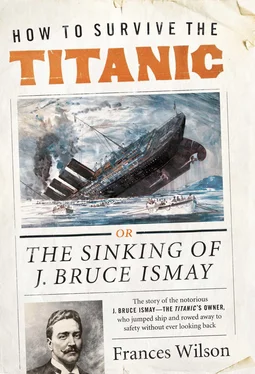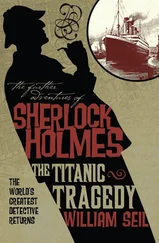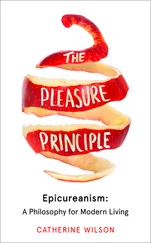It was in New York that Ismay met Harold Sanderson. No relation of the Sandersons of Elstree, Harold, who was born in 1859, came from old Yorkshire stock and was the eldest son of Richard Sanderson, who ran a shipping agency in Birkenhead for the Wilson Line of Hull. In the early 1880s, Richard Sanderson had left England to represent the Wilson Line in New York. Here, with Harold and his younger brothers, he founded his own shipping firm of Sanderson and Sons. Six foot two and as lean as a greyhound, Harold Sanderson was ‘courteous and considerate to a degree hardly attainable by others’, with a reputation for honesty in business. 23United by their youth, nationality, professions and physiques, Sanderson and Ismay became friends.
Harold Sanderson had married his wife, Maud Blood, in New York in 1885 and it was his example that Ismay was following when he gave up his life of pleasure in 1887 and proposed to Florence Schieffelin, ‘a charming girl with real brown hair, beautiful eyes and a singularly winsome manner’. 24Maud Blood, to whom Sanderson was devoted, was from a cultured and well-travelled family and had been educated in Germany, Switzerland and Italy. Florence Schieffelin, the eighteen-year-old daughter of one of New York’s oldest families, came from similar stock. The Schieffelins originated from Nordlington, near Nuremberg; a forebear had been a distinguished artist and pupil of Albrecht Dürer. Florence’s father, George, was a graduate of Columbia and a prominent New York attorney; her mother, Margaret, was the granddaughter of John Ferris Delaplaine, a wealthy New York shipping merchant. Within weeks of setting eyes on her, during a Thanksgiving Day party at the Tuxedo Club in New Jersey, Ismay asked Florence to marry him. Neither father approved of the match and George Schieffelin, who doted on his daughter, suggested that the couple wait a year. When he finally gave his consent, it was on the grounds that Ismay promised always to keep Florence in America. The arrangement suited Ismay perfectly. They were married in December 1888 in the Church of the Heavenly Rest on Fifth Avenue, before what the New York Times called ‘a fashionable assemblage’. The bride, celebrated as the ‘belle of the city’, wore lace and diamonds and carried a bouquet of lilies-of-the-valley. The papers described Ismay as ‘a fine specimen of young manhood, being about twenty-six years of age, tall and graceful. He has, at this early age, achieved what might be deemed an enviable position in the marine world where he is widely known, popular and a great favourite, as he is also in the social world of New York.’ The wedding breakfast was held at the Schieffelin family home on East Forty-Ninth Street, after which the Ismays moved into a house at 444 Madison Avenue.
The groom’s family did not attend the ceremony; Thomas Ismay was too busy with Lord Hartington’s Commission on the administration of the Army and Navy. A proud man, Ismay Senior nurtured doubts about the clan Bruce was marrying into: the Schieffelins were not only foreigners but also upper class, with all the attendant notions of superiority. He was equally uncomfortable when, in 1892, James married Lady Margaret Seymour, the eldest daughter of the Marquis of Hertford. He did not want it thought that he tried to advance his family by engineering ‘good’ marriages; the sons of Thomas Ismay did not need to marry well in order to prove themselves gentlemen. He and Margaret did not meet Florence until after the wedding, when Bruce brought his bride to England. Their arrival at Dawpool was then celebrated as befits the son of the lord of the manor, with the ringing of bells, fireworks and a dinner for one thousand of the residents of Thurstaston.
A daughter, Margaret, was born to the newlyweds in late 1889 after which, in September 1890, Thomas, who wanted to retire from the company but remain involved as its chairman, again suggested that Bruce become a partner, along with James who was just down from Oxford. The offer was once more contingent on Ismay’s return to England. Should he turn it down, the position would go to James. Ismay, who resented the idea of being overtaken by a preferred brother with no interest in ships and none of his own experience — Bruce had now worked for the White Star Line for ten years — had little choice. He was caught between the demands of his father and the promise he had made to his father-in-law to keep Florence in America, and Thomas doubtless enjoyed playing the trump card in the power struggle between the two patriarchs. George Schieffelin reluctantly released his son-in-law from his bond, and in January 1891 he saw his daughter, his granddaughter, and his six-month-old grandson, Henry, off to Liverpool on board the White Star liner, the Teutonic.
The crossing was a disaster. Florence was seasick, baby Henry became ill; Florence wanted to nurse him but Ismay insisted on using an inexperienced maid. The baby’s illness worsened, and soon after they landed, Henry died at Dawpool. The event brought to an end what marital happiness the Ismays had briefly known. Bruce, who would never recover from his young son’s death, now fixed his affections on his daughter. Florence had sacrificed her child and her country to start a new life in a drab Liverpool suburb with a man she no longer recognised.
Margaret Ismay suggested that the young family stay at Dawpool until they found a suitable home of their own, but it was an idea Thomas could not countenance. His life was ordered with military precision; if he saw a fallen leaf on the drive when he left for work in the morning he would put a stone on it; should it still be there when he returned in the evening he demanded of the gardeners what they had been doing all day. The thought of having at the heart of his empire a taciturn son, a tearful American and an unpredictable two-year-old granddaughter was intolerable, so he rented for them what Florence called a ‘horrid house’ several miles away, and threw in the use of a servant to help with the cooking.
Bruce immersed himself in work, determined that his father would have no grounds for criticising him. There were no more weekend jaunts for the couple, no more dances. Pleasures that he and Florence had once enjoyed together, such as the theatre, he now preferred to do alone, slipping out to a matinee during a quiet afternoon. Unlike his father, who had shared all his business concerns with his wife, Ismay shared nothing with Florence. He would think his problems through in solitude during long walks, or on the top deck of the trams in which he would travel around and around the city. He stuck to a clockwork routine, leaving the house at the same time every morning and returning at the same time every night, bringing with him what Florence referred to as his ‘dreaded dispatch box’. The only outings with his wife were now dinners at Dawpool, which Florence also thought horrid. Her presence there, however, added a lightness of touch and Ismay’s four sisters adored her. Regardless of Thomas’s expectation that women remain mute at the table and disengage themselves from the wider world, Florence, swallowing her homesickness and dressed in the latest fashions, chattered away in her American accent about her family and New York. Ismay, meanwhile, turned inwards. He grew to hate noise and particularly parties, but there was nothing he now disliked so much as a wedding.
It was Ismay’s suggestion that Harold Sanderson leave Sanderson and Sons in the hands of his younger brothers and take on the job of general manager of the White Star Line in Liverpool. With Sanderson on board, Ismay would have a colleague to whom he could relate while Florence would have, in Maud, a compatriot as a neighbour. The job would be a step up the ladder for Sanderson, and Thomas Ismay, impressed that his son was making sensible decisions, agreed to take him on, making Harold Sanderson the White Star Line’s first major outside appointment. So in 1894 the Sanderson family, along with their six-foot-tall black nanny, arrived in Liverpool and moved into a sandstone house called Holmfield, which was next door to Sandheys, the late Georgian house in which the Ismays now lived in the suburb of Mossley Hill. Holmfield was soon filled with Maud’s childhood friends from the continent, and the Sanderson children grew up in a ‘babel of languages’. 25To escape from his own silent household, Ismay took Sanderson for epic cycling trips, the two men sometimes covering up to seventy-five miles a day.
Читать дальше












